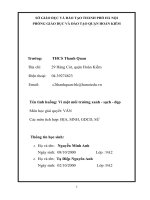Nhom 2 Tich hop lien mon
Bạn đang xem bản rút gọn của tài liệu. Xem và tải ngay bản đầy đủ của tài liệu tại đây (2.6 MB, 20 trang )
<span class='text_page_counter'>(1)</span>Welcome to the Presentation.
<span class='text_page_counter'>(2)</span>
<span class='text_page_counter'>(3)</span> The formation and development of Association of Southeast Asian Nations (ASEAN).
<span class='text_page_counter'>(4)</span> I. The formation of Association of Southeast Asian Nations (ASEAN). The development of Association of Southeast Asian Nations (ASEAN). I. Organizational structure of Association of Southeast Asian Nations (ASEAN).
<span class='text_page_counter'>(5)</span> The formation of ASEAN • After their independence, the countries need to cooperate to help each other to grow • To limit the influence of big countries outside, especially US. • The regional integration organizations appear more and more so that they urged Southeast Asian countries to link together..
<span class='text_page_counter'>(6)</span> • ASEAN is a regional group founded on 8 August 1967 by Indonesia, Malaysia, Singapore, Thailand and the Philippines ..
<span class='text_page_counter'>(7)</span> • The ASEAN was formed when the foreign ministers – Adam Malik of Indonesia, Narciso Ramos of the Philippines, Tun Abdul Razak of Malaysia, S. Rajaratnam of Singapore and Tun Thanat Khoman of Thailand – of the five founding member states convened in the Department of Foreign Affairs building in Bangkok to sign the ASEAN Declaration..
<span class='text_page_counter'>(8)</span> The Objectives: • To promote economic growth, social progress, and cultural development in the region • To promote regional peace and stability • To serve as a forum for the resolution of intra-regional differences.
<span class='text_page_counter'>(9)</span> The Association represents the collective will of the nations of Southeast Asia to bind themselves together in friendship and cooperation and, through joint efforts and sacrifices, secure for their peoples and for posterity the blessings of peace, freedom, and prosperity..
<span class='text_page_counter'>(10)</span> The development of ASEAN - From 1967–1975 ASEAN had a cautious beginning; activities were very low key and the emphasis was on communication and confidence– building. - The Zone of Peace, Freedom and Neutrality (ZOPFAN) is a declaration signed on 1971 in Kuala Lumpur, Malaysia. - Treaty of Amity and Cooperation in Southeast Asia (Bali) signed on 24 February 1976 in Indonesia..
<span class='text_page_counter'>(11)</span> The Treaty of Amity and Cooperation (TAC) in South-East Asia declared that in their relations with one another, the High Contracting Parties should be guided by the following fundamental principles: - Respect for the independence, sovereignty, equality, territorial integrity, and national identity of all nations - Shared commitment: peace, security stability - Non-interference in the internal affairs of one another - Settlement of differences or disputes by peaceful manner.
<span class='text_page_counter'>(12)</span> -Renunciation of the threat or use of force. - Effective cooperation among themselves.
<span class='text_page_counter'>(13)</span> - Solve Cambodia’s problem by political solutions , so the relation amon ASEAN with 3 Indochinese countries was improved.. - On 7 January 1984 , Brunei Darussalam became ASEAN's sixth member, barely a week after gaining independence. - On 28 July 1995, Vietnam became ASEAN's seventh member.
<span class='text_page_counter'>(14)</span> - Laos and Myanmar (Burma) joined two years later on 23 July 1997 - On 30 April 1999 , Cambodia became ASEAN's tenth member .. ASEAN-10.
<span class='text_page_counter'>(15)</span> The ASEAN Flag represents a stable, peaceful, united and dynamic ASEAN . There are ten sheaves of rice stalks, one for each country. The colors reflect those of the flags of all of the countries..
<span class='text_page_counter'>(16)</span> - The ASEAN Community was established in 2015..
<span class='text_page_counter'>(17)</span> - ASEAN Summit. - ASEAN Coordinating Council.
<span class='text_page_counter'>(18)</span> - ASEAN Community Councils + ASEAN Political - Security Community (APSC) + ASEAN Economic Community (AEC) + ASEAN Socio - Cultural Community (ASCC). - Committee of Permanent Representatives (CPR) - Secretary general and Secretariat of ASEAN. ASEAN Secretary General Le Luong Minh.
<span class='text_page_counter'>(19)</span> The headquarters of ASEAN - ASEAN National Secretariat.
<span class='text_page_counter'>(20)</span>
<span class='text_page_counter'>(21)</span>









